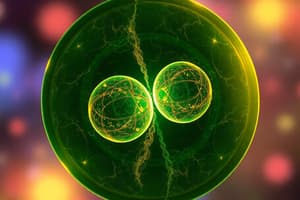Podcast
Questions and Answers
What occurs during interphase in relation to DNA?
What occurs during interphase in relation to DNA?
- DNA is replicated into double stranded chromosomes. (correct)
- DNA is condensed into chromosomes.
- DNA is packaged into ribosomes.
- DNA is deleted to maintain cellular function.
What is the end result of mitosis?
What is the end result of mitosis?
- Four genetically diverse daughter cells.
- One single daughter cell.
- Two genetically identical daughter cells. (correct)
- Two daughter cells that differ in genetic makeup.
Which statement best describes the relationship between mother and daughter cells after mitosis?
Which statement best describes the relationship between mother and daughter cells after mitosis?
- Daughter cells have different genetic information than the mother cell.
- Daughter cells are always larger than the mother cell.
- Daughter cells do not contain any chromosomes.
- Daughter cells are genetically identical to the mother cell. (correct)
What transformation occurs to chromosomes during the S phase of interphase?
What transformation occurs to chromosomes during the S phase of interphase?
Which of the following is NOT true regarding the outcome of mitosis?
Which of the following is NOT true regarding the outcome of mitosis?
What is the primary event that occurs during the first meiotic division?
What is the primary event that occurs during the first meiotic division?
How many daughter cells are produced at the end of meiosis I?
How many daughter cells are produced at the end of meiosis I?
What type of chromosomes are contained in each daughter cell after meiosis I?
What type of chromosomes are contained in each daughter cell after meiosis I?
Which of the following best describes the genetic content of the daughter cells after meiosis I?
Which of the following best describes the genetic content of the daughter cells after meiosis I?
What is the state of the chromosomes at the start of meiosis I?
What is the state of the chromosomes at the start of meiosis I?
Flashcards are hidden until you start studying
Study Notes
Interphase
- DNA replicates during interphase, converting single-stranded chromosomes into double-stranded chromosomes.
Mitosis
- Mitosis results in two daughter cells, each genetically identical to the mother cell.
Meiosis I
- Characterized by pairing of homologous chromosomes
- Results in two daughter cells, each containing 23 double-stranded chromosomes.
Meiosis II
- Characterized by the division of 23 double-stranded chromosomes at the centromere, resulting in 23 single-stranded chromosomes.
- Results in four daughter cells, each containing 23 single-stranded chromosomes.
Karyotyping
- Karyotyping is a test that analyzes chromosomes.
- It is used to identify chromosomal abnormalities.
Gametogenesis
- Process of gamete formation through cell division.
- Lasts approximately two months (60 days).
- Begins at puberty (13-16 years old) and continues until old age.
- Involves four stages: proliferation, growth, maturation, and spermiogenesis.
Stages of Spermatogenesis
- Proliferation: Spermatogonia undergo mitosis, increasing their number.
- Growth: Spermatogonia increase in size, becoming primary spermatocytes.
- Maturation:
- Meiosis I: Primary spermatocytes (46 double-stranded chromosomes) produce two secondary spermatocytes (23 double-stranded chromosomes).
- Meiosis II: Secondary spermatocytes (23 double-stranded chromosomes) produce two spermatids (23 single-stranded chromosomes).
- Spermiogenesis: Spermatids transform into sperm.
Spermiogenesis
- Morphological transformation of spermatids into mature sperm (spermatozoa).
- Involves the following changes:
- Nucleus: Condenses and forms the majority of the sperm head.
- Golgi Apparatus: Covers the anterior 2/3 of the nucleus, forming the head cap or acrosome of the sperm.
- Centrioles: Migrate to the opposite side of the nucleus, elongate, and form the flagellum, which becomes the tail of the sperm.
- Mitochondria: Surround the first part of the tail and are responsible for energy production for sperm movement.
- Cytoplasm: Most of the cytoplasm of the head is removed by Sertoli cells.
Studying That Suits You
Use AI to generate personalized quizzes and flashcards to suit your learning preferences.





